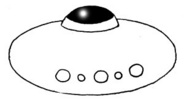Abralia redfieldi
Kotaro Tsuchiya and Richard E. YoungIntroduction
A. redfieldi is widely distributed in the Atlantic Ocean. This species is very similar to the Pacific species A. similis, but separable by the larger numbers of arm hooks (13-16 vs. 6-12 in A. similis).
Characteristics
- Tentacle clubs
- Hectocotylus
- Right ventral arm of male hectocotylized.
- Hectocotylus with very large bilobed flap, distal to arm hooks, on ventral margin and small, more distal flap on dorsal margin.
- Eye Photophores
- Five, silvery organs.
- Integumental Photophores
- Ventral mantle and head with scattered arrangement of integumental organs.
- Ventral mantle and head with scattered arrangement of integumental organs.
- Epidermis
- Thick, fragile, and gelatinous.
Comments
A. redfieldi is related with A. similis, and A. omiae in their:- Five monotypic, silvery eye photophores.
- Large, bilobed proximal flap of hectocotylus.
- Small size and thick, gelatinous epidermis.
A. grimpei also resembles the above species but has more than 5 eye photophores.
| A. redfieldi | A. grimpei | A. similis | A.omiae | |
| Lateral head photophore series | complete (ususally | Complete | Incomplete | incomplete |
| Club hooks | 2-3 | 2 | 2 | 1-2 |
| Arm II photophores | 1 | 1 | ||
| Hooks on hectocotylus | 6-8 | |||
| Photophores on mantle | Clear strip, two bands (often) | Clear strip, two bands | Scattered | Clear strip, two bands |
| Eye photophores | 5, sometimes 6 | >5 | 5 | 5 |
| mid-head photophores | i series |
Distribution
well oo(1983)Vertical distribution
One specimen was caught during night by midwater tow at a depth of 100-50m at 10° N, 20° W (Lu & Clarke, 1975)Geographical distribution
Type locality: Off Gun Cay, Bahamas (western North Atlantic).
General distribution: "Tropical waters of western Atlantic, from the northern part of the Sargasso Sea to north-eastern Brazil, abundant near Bahamas, Bermuda, Great and Small Antilles, but absent from the slope of America. It occurs also in western Africa near Senegal." (Nesis, 1982, translation provided by M. Lipinski). Lipinski (1983) extended the range to 45°S, 54°W (western South Atlantic, well off southern Argentina).
References
Lipinski, M. 1983. A description of a new species of enoploteuthid cephalopod, Abralia siedleckyi spec. nov., with some remarks on Abralia redfieldi G. Voss, 1955. Veliger, 25(3):255-265.
Lu, C. C. and M. R. Clarke, 1975. Vertical Distribution of cephalopods at 11° N 20° W in the North Atlantic. Journal of the Marine Biological Association of the United Kingdom, 55 (2): 369-389.
Nesis, K.N. 1982. Abridged key to the cephalopod molluscs of the world’s oceans. Moscow: Light and Food Industry
Publishing House, 385 pp. (In Russian).
Tsuchiya, K. 2000. Illustrated book of the Enoploteuthidae. In: Okutani T., ed. True face of Watasenia scintillans. Tokai University Press, Tokyo, p 196–269. (in Japanese)
Voss, G.L. 1955. The Cephalopoda Obtained by the Harvard-Havana Expedition off the Coast of Cuba in 1938-39. Bulletin of Marine Science of the Gulf and Caribbean, 5(2):81-115.
Title Illustrations

| Scientific Name | Abralia redfieldi |
|---|---|
| Location | Northwestern Atlantic |
| Comments | Eyes damaged during capture. |
| Specimen Condition | Fresh |
| Identified By | M. Vecchione |
| Size | 34 mm ML |
| Image Use |
 This media file is licensed under the Creative Commons Attribution-NonCommercial License - Version 3.0. This media file is licensed under the Creative Commons Attribution-NonCommercial License - Version 3.0.
|
| Copyright |
©

|
About This Page
Drawings from Voss (1955) and Cairns (1976) printed with the Permission of the Bulletin of Marine Science.

Tokyo University of Fisheries, Tokyo, Japan

University of Hawaii, Honolulu, HI, USA
Page copyright © 2018 and
 Page: Tree of Life
Abralia redfieldi .
Authored by
Kotaro Tsuchiya and Richard E. Young.
The TEXT of this page is licensed under the
Creative Commons Attribution-NonCommercial License - Version 3.0. Note that images and other media
featured on this page are each governed by their own license, and they may or may not be available
for reuse. Click on an image or a media link to access the media data window, which provides the
relevant licensing information. For the general terms and conditions of ToL material reuse and
redistribution, please see the Tree of Life Copyright
Policies.
Page: Tree of Life
Abralia redfieldi .
Authored by
Kotaro Tsuchiya and Richard E. Young.
The TEXT of this page is licensed under the
Creative Commons Attribution-NonCommercial License - Version 3.0. Note that images and other media
featured on this page are each governed by their own license, and they may or may not be available
for reuse. Click on an image or a media link to access the media data window, which provides the
relevant licensing information. For the general terms and conditions of ToL material reuse and
redistribution, please see the Tree of Life Copyright
Policies.
- Content changed 29 March 2018
Citing this page:
Tsuchiya, Kotaro and Richard E. Young. 2018. Abralia redfieldi . Version 29 March 2018 (under construction). http://tolweb.org/Abralia_redfieldi/19661/2018.03.29 in The Tree of Life Web Project, http://tolweb.org/













 Go to quick links
Go to quick search
Go to navigation for this section of the ToL site
Go to detailed links for the ToL site
Go to quick links
Go to quick search
Go to navigation for this section of the ToL site
Go to detailed links for the ToL site